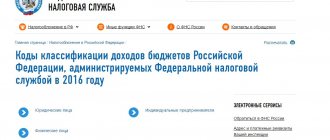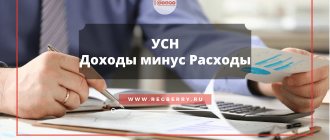Formation of the cost of goods
The concept of the cost of goods for “simplified people” in Chapter.
26.2 of the Tax Code of the Russian Federation is not disclosed. Also in ch. 26.2 there are no references to Ch. 25 of the Tax Code of the Russian Federation, which defines the rules for determining the cost of goods (Article 320 of the Tax Code of the Russian Federation). The cost of goods is formed based on their price paid to the supplier according to the contract. Other expenses incurred by the buyer during acquisition and sale are not included in the cost of goods and are written off separately.
In addition, the VAT paid to the seller should be deducted from the cost of goods (price of goods), since the tax is written off on the basis of sub-clause. 8, 23 clause 1 art. 346.16 of the Tax Code of the Russian Federation is carried out under a separate expense item. The amount of VAT paid is shown in a separate line of the Book of Income and Expenses (letter of the Ministry of Finance of Russia dated January 18, 2010 No. 03-11-11/03, dated December 2, 2009 No. 03-11-06/2/256).
Read more about accounting for “input” VAT on purchased goods in the article “We take into account VAT in expenses - special conditions.”
The cost of goods is recognized as an expense subject to payment for them with the supplier and only after they are sold to the buyer. There is no need to wait to receive payment from the buyer.
Check whether you are correctly writing off purchased goods and taking into account VAT on them, using a Ready-made solution from ConsultantPlus. If you do not have access to the K+ system, get a trial demo access for free.
Unrealized right to deduct VAT: special cases
A situation where a company has not exercised its right to deduct VAT can arise for various reasons. The most common of them are the following:
- lack of invoices issued by the seller;
- missing the deadline to claim a deduction.
The first situation often arises when making a purchase in a retail chain. Most often these are some “little things”, for example, stationery for office needs or refueling a car. In this case, it is unlikely that you will be able to obtain an invoice from the seller, and in the opinion of the tax service, it is unlawful to claim VAT deduction based on a cash receipt. The absence of an invoice will be identified immediately when the company's VAT return is processed by the tax office's automated system.
It turns out that it is impossible to deduct the amount of VAT on purchased assets, but at the same time, as mentioned above, it cannot be attributed to expenses that reduce the income tax base. However, those companies and entrepreneurs who want to fight for the deduction of the tax amount in this situation in court have every reason to do so.
The Resolution of the Presidium of the Supreme Arbitration Court No. 17718/07 dated May 13, 2008 determined that under such circumstances it is unlawful to refuse a taxpayer a VAT deduction. This is true provided that there is a cash receipt confirming the purchase, and also the fact that the taxpayer used the purchased goods outside the scope of taxable activity has not been proven.
Nevertheless, the official position of the Federal Tax Service has not changed: VAT can be deducted only on the basis of an invoice , and issues of presenting other primary documents as justification for the deduction are resolved in court.
Speaking about the second obvious reason why a taxpayer may lose the right to deduct VAT, let us turn to paragraph 1.1 of Article 172 of the Tax Code of the Russian Federation. Since its entry into force, namely from the beginning of 2015, the procedure for applying for VAT deduction within three years from the date of registration of goods has been legislated. However, this deadline may also be missed, for example, by mistake or due to lengthy preparation of documents. Be that as it may, it is unlawful to claim VAT deduction outside this period. That is, in this case, the tax will have to be paid, but it will not be possible to attribute its amount to income tax expenses.
As an illustration, let us cite the situation of a Russian exporting company that took too long to collect a package of documents to confirm the zero VAT rate. As a result, she declared “input” tax on transactions taxed at 0% beyond the three-year period, and on this basis was denied a deduction. The amount of tax that the company had to pay was included in income tax expenses, however, the Supreme Arbitration Court did not agree with this position (determination of the Supreme Arbitration Court of the Russian Federation No. 305-KG15-1055 dated March 24, 2015).
An example of a situation where VAT can be attributed to expenses
Another special case is also related to the non-confirmation of the zero VAT rate, but this is not about the tax presented by the taxpayer, but about the cost of his services calculated “on top of” the cost of his services. The situation was discussed in the letter of the Ministry of Finance No. 03-03-06/1/42961 dated July 27, 2015. The department is of the opinion that if the legality of applying the zero VAT rate cannot be confirmed, then the amount of calculated tax at a rate of 18 or 10% on the basis of subparagraph 1 of paragraph 1 of Article 264 of the Tax Code of the Russian Federation should be taken into account as expenses.
In making this conclusion, the Ministry of Finance refers to the resolution of the Supreme Arbitration Court of the Russian Federation dated April 9, 2013 No. 15047/12, issued in a dispute between a large Russian air carrier and the Federal Tax Service. The company failed to collect documents to confirm zero VAT, calculated it at a rate of 18%, paid and included this amount as expenses that reduce profits. The tax service saw this as a violation. However, the Supreme Arbitration Court did not agree with this position and explained that the dispute concerns VAT calculated “from above.” In this case, the rules of tax legislation regarding the accounting of these amounts as expenses should be applied. The court also indicated that this VAT should be expensed immediately after the expiration of the 180-day period provided for submitting documents confirming the zero rate.
Methods for writing off the cost of goods as expenses
The Tax Code of the Russian Federation allows you to choose one of the following methods for writing off the costs of paying for purchased goods (subclause 2, clause 2, article 346.17 of the Tax Code of the Russian Federation):
- at the cost of the first in time of acquisition (FIFO);
- average cost;
- unit cost of goods.
NOTE! The LIFO method is excluded from the possible methods used.
The Russian Ministry of Finance allows the establishment of different methods for writing off costs for different groups of goods (Letter dated 01.08.2006 No. 03-03-04/1/616). Despite the fact that the clarifications in the letter concern the valuation of goods when calculating income tax, it can be assumed that even under the simplified tax system it is not prohibited to be guided by these clarifications.
The accounting policy for tax purposes must specify the chosen valuation method, and if there are several of them, then it is necessary to describe the groups of goods for which one or another method is applied.
A sample accounting policy for the simplified tax system “income minus expenses” can be found here.
The Tax Code of the Russian Federation does not stipulate how to apply valuation methods in practice, however, a description of all methods of writing off costs for the purchase of goods is contained in paragraphs 17–19 of the Accounting Regulations “Accounting for inventories” PBU 5/01, approved by order of the Ministry of Finance Russia dated 06/09/2001 No. 44n.
If the taxpayer’s sales volume is small, then he usually does not have problems when using any of these methods. So, for example, it is enough to simply track for each unit of goods whether payment was made to the supplier and whether this product was subsequently sold. These are the two conditions that are necessary for accepting the cost of purchased goods as expenses. When maintaining tax accounting registers, you will need to enter information about the acquisition of goods, their sale, payment to the supplier and receipt of payment from buyers.
With a wide range of products, a large volume of sales and keeping records of sales prices, it is quite difficult for the taxpayer to apply the above methods for valuing goods. For example, retail businesses that issue a cash register receipt for a total amount without detailing it find it difficult to track compliance with the requirements that allow them to include the cost of purchased goods in expenses.
In such a situation, you can calculate the cost of goods to include it in expenses using a special formula proposed by the Ministry of Finance of Russia in its letter dated April 28, 2006 No. 03-11-04/2/94. Initially, the clarifications concerned the transition period of 2006, but even now they have not lost their relevance.
Simplified taxation system “income – expenses”
When forming the taxable base “income – expenses”, a rate of 15% is applied. It can be lowered by regional authorities in the range from 5 to 15%. Or establish a differentiated rate for different categories of taxpayers. For example, in St. Petersburg, for all taxpayers using the simplified tax system “income-expenses”, the tax rate is 7%.
Tax payable is calculated as follows:
A special feature of this type of simplified taxation system is the need to pay a minimum tax. It is 1% of the proceeds received. It must be paid even if the company suffered a loss as a result of its activities.
FIFO method
When using the FIFO method, expenses take into account the cost of those goods that were purchased earlier than others. When purchasing goods in batches, it is first necessary to write off goods from the first received batch, if it is insufficient - from the second, etc. in order.
This method is convenient to use for writing off the cost of goods whose prices decrease over time, or for the subsequent provision of cumulative discounts by sellers. After all, first of all, expenses take into account the cost of goods purchased at the highest price.
Example
Sever LLC is engaged in the resale of refrigerators. On September 5, the company purchased and paid for the first batch of 8 Atlant refrigerators at a price of RUB 8,500.00. per piece (without VAT). On September 15, the second batch of 12 such refrigerators was received and paid for at a price of RUB 8,300.00. per piece (without VAT). In total, Sever LLC sold 14 refrigerators in September.
The accountant of Sever LLC needs to write off the costs of purchasing refrigerators as follows:
- 8 refrigerators for the price of RUB 8,500.00. from the first batch – 68,000.00 rubles;
- 6 refrigerators for the price of RUB 8,300.00. from the second batch – RUB 49,800.00.
It turns out that in September the expenses will take into account:
RUB 68,000.00 + 49,800.00 rub. = 117,800.00 rub.
Problems due to incorrect settings
Generally speaking, there can be many of them. For example, if you enter the initial balances of goods or materials, then with “average” accounting selected (if you managed to set it), the program will still require a batch document and the document will not be posted at all. This is all because in some versions of 1C Accounting 8.3 Taxi you can still disable batch accounting and FIFO, but with USN 15 the document posting module will still require this data.
Simply put, you shouldn’t be tricky with the 1C settings and do it right. Then it will be easier for you!
Write-off method based on the cost of each unit
The method is quite simple, since each unit of goods is written off as expenses at the cost of its acquisition.
The write-off method based on the cost of each unit is suitable for those organizations that trade unique single products or with a small range of products.
Example
Volga LLC is engaged in the trade of gas equipment and keeps records of goods at the cost of each unit. Under the supply agreement, in February the organization purchased and paid for a universal boiler that runs on solid and liquid fuels at a cost of 120,000 rubles. In March, the boiler is sold by the Kama organization for 158,000 rubles, which immediately pays for this equipment. This means that Volga’s expenses for September should take into account the cost of purchasing a boiler in the amount of 120,000 rubles.
Average cost write-off method
The average cost write-off method is used for one type or one group of goods. In this case, the cost of goods written off as expenses is determined in 2 stages.
First of all, it is necessary to calculate the average cost of the type of goods purchased for subsequent sale; for this, the total cost of goods available in the warehouse at the beginning of the month and received during the month is divided by the number of these goods available in the balance at the beginning and received during the month. Only those goods for which payments were made to suppliers are taken for calculation.
| Average unit cost | = | Cost of inventory balances at the beginning + cost of goods received | / | Number of goods at the beginning of the month + number of goods received |
At the second stage, the cost of goods sold is calculated, which can be included in expenses.
| Price goods included in expenses | = | Quantity implemented goods | X | average cost units goods |
Example
In November, Gaz-M LLC purchased three lots of gas meters SGBM-1.6, SGBM-2.5, SGBM-3.2 for resale to the public:
- batch SGBM-1.6 - 60 meters at a price of 1,200 rubles. per piece (without VAT);
- batch SGBM-2.5 – 120 meters at a price of 1,280 rubles. per piece (without VAT);
- batch SGBM-3.2 - 80 meters at a price of 1,320 rubles. per piece (without VAT);
Payment was made to the supplier in the same month.
As of 01.11, Gaz-M had 35 meters in its warehouse in the amount of 41,700.00 rubles.
During November, 180 meters of various prices were sold.
The accounting policy of Gaz-M LLC establishes a method for writing off the cost of goods as expenses based on the average cost of a group of goods.
We need to determine the cost of goods that needs to be written off as expenses for November.
Let's calculate:
- cost of goods received:
60 pcs. × 1,200 rub. + 120 pcs. × 1,280 rub. + 80 pcs. × 1,320 rub. = 331,200 rub.;
- cost of received meters taking into account the balance at the beginning of the month:
RUB 41,700 + 331,200 rub. = 372,900 rub.;
- total number of meters received, taking into account the balance at the beginning of the month:
35 pcs. + 60 pcs. + 120 pcs. + 80 pcs. = 295 pcs.
Thus, the average cost per unit of goods was equal to:
RUB 372,900 / 295 pcs. = 1264 rub.
Based on the average cost per unit of goods, the accountant will determine the amount of expenses that he will take into account in November:
180 pcs. × 1264 rub. = 227,520 rub.
See also “Methods for estimating inventories”.
Where to include VAT when re-importing?
Goods that the exporter for some reason is forced to import back into the country are placed under the customs procedure of re-import. In practice, customs authorities generally charge VAT on the value of such goods. The legality of this can be debated, but taxpayers usually prefer to pay the tax in order to get their own goods back as soon as possible. And here the question arises: what to do next with the amount of this tax?
Let us immediately note that VAT paid during re-import cannot be deducted. Paragraph 2 of Article 171 of the Tax Code of the Russian Federation lists all cases when customs VAT can be deducted, and operations for the re-import of goods do not appear there. Based on Article 170 of the Tax Code of the Russian Federation, the amount of tax also cannot be included in the cost of imported goods. After all, most likely, they will be sold in the future, that is, used in activities subject to VAT.
According to experts, it is advisable to attribute VAT withheld when re-importing goods to other expenses that reduce taxable profit, as a tax paid in accordance with the law.
And although paragraph 19 of Article 270 directly prohibits the inclusion of VAT in expenses, it refers to the tax presented by the taxpayer. When re-importing, the owner of the goods does not present the withheld VAT to anyone, therefore, the specified legal norm is not applicable to this situation. This is confirmed by judicial practice. Thus, customs VAT withheld during re-import can be included in other expenses taken into account when calculating the income tax base.
Results
To recognize the cost of purchased goods as expenses under the simplified tax system, several conditions must be met: the organization applies the taxation object “income minus expenses”, the goods are paid to the supplier and sold to the buyer.
If these conditions are met, the cost of purchased goods sold is determined by one of the methods specified in the organization’s accounting policies. You can find more complete information on the topic in ConsultantPlus. Free trial access to the system for 2 days.






